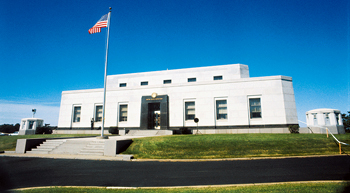|
"Making Cents"
Saturday, April 19, 2008
| A |
Most people complied. As a result, by early 1935, it was evident that the country was running out of space to store all of the gold ingots and coins. The various Federal Reserve banks ran out of storage space, and the branch mints were also running out of space.
In 1936, the Treasury Department began construction of the United States Bullion Depository at Fort Knox, Ky. The land was transferred from the army to the Treasury Department. The Gold Vault was completed in December 1936 at a cost of $560,000. The first gold shipments arrived between January and July 1937, requiring some 500 rail cars from all across the country.
Most of the bullion was made from the processing of gold into bricks of fairly uniform size and purity — .999 fine, or 24k. The ingots made directly from melted coins were stamped as 22k gold, or 91.67% gold.
At my bar mitzvah in 1944, my aunt Minnie gave me a $2-1/2 gold piece as a gift. My Uncle Ben gave me two $2-1/2 gold pieces. My parents, fearing their small stash of gold coins might be confiscated, spent them at a local appliance store during World War II for some household items including a giant radio.
In more recent years, I have evaluated coin hoards of many older Americans who also had put away a few gold coins rather than cash them at face value back in the 1935-1937 era. Many gold coins were shipped to bank vaults in Switzerland.
In 1971, when I worked for A-Mark Co. in Los Angeles, I was in charge of examining the gold coins A-Mark bought from these sources. Because all U.S. gold coins were of uniform prices, I sought out the scarcer-date coins to be resold at higher-than-bullion prices. Apparently millions of U.S. gold coins were shipped overseas to avoid the Gold Act of 1933.
During World War II, the amount of gold in storage peaked at 649.6 million troy ounces, or 20,205 metric tons. The latest current holdings are around 147.3 million ounces. The dollar value in 2007 exceeded $125 billion. Today's value is considerably higher.
The famous 1933 double eagle which sold at $7.59 million in 2002 was stored at Fort Knox. The ten 1933 double eagles turned over the Treasury in 2004 are also in storage there until their status is resolved. The Treasury claims they were stolen from the Mint in 1933. They showed up in 2004 in the estate of the late Israel Switt.
Other treasures are or were stored at Fort Knox. The Hungarian crown of St. Stephen was stored there to avoid falling into the hands of the Soviets after World War II. It was later returned to Hungary for their National Museum. Famous documents including an original Declaration of Independence and the U.S. Constitution are also stored at Fort Knox.
To dispel recurring themes of conspiracies, the vault has been opened for inspection as well as various audits.
One theory is that the vault was emptied and the gold shipped to London during the Johnson administration. To dispel that idea, Sen. Walter Huddleston of Kentucky, twelve congressmen and about 100 members of the media toured the interior of the vault on Sept. 23, 1974, and verified that the individual cells of the gold vault were indeed filled with gold bullion.
Audits conducted from 1975 to 1981 also verified the contents of the vaults (the big vault is subdivided into smaller vaults or cells). If all of the gold at Fort Knox were melted into a single cube, it would measure 19.6 meters on one side (64.3 feet) with a volume of approximately 7,529.5 meters cubed.
The United States holds more gold bullion than any other country, with Germany a distant second at less than half that amount. In addition, the Treasury in lower Manhattan holds several million ounces of gold bullion belonging to other countries, as well as private holdings and additional U.S. gold reserves. Gold is also stored in smaller amounts at the various U.S. mints and in various Federal Reserve banks.
In 1971, the restriction on gold coin ownership was lifted and gold coins reappeared — more so than before — in the numismatic marketplace.
In a 1937 film, "Behind the Headlines," the plot was to steal the gold en route from Washington to Fort Knox. In the 1951 comedy with Abbott and Costello, "Comin' Round the Mountain," the duo follow a treasure map to find themselves at Fort Knox and are immediately taken into custody.
The public is reassured that the gold at Fort Knox is very secure, and any shipments in or out are under the tightest of security measures.
Dr. Sol Taylor of Sherman Oaks is president of the Society of Lincoln Cent Collectors and author of The Standard Guide to the Lincoln Cent. Click here for ordering information.
©2008 SCV COMMUNICATIONS GROUP & SOL TAYLOR · ALL RIGHTS RESERVED.

![[Most Recent Quotes from www.kitco.com]](http://www.kitconet.com/images/quotes_special.gif)

